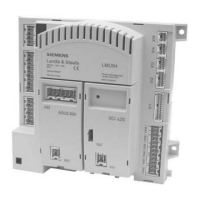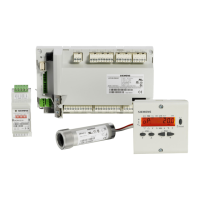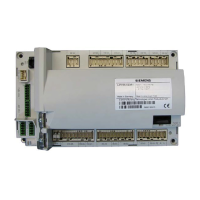75/171
Siemens Building Technologies Basic Documentation LMU54... / LMU64... CC1P7494en
HVAC Products 3 Functions 07.11.2002
In the case of systems that use a room thermostat, the switching state of that contact
decides on the demand for heat that shall be generated:
Input of room thermostat open: RT = 0
Input of room thermostat closed: RT = 1
If no room thermostat is connected, the demand for heat will stay locked (RT1 = 0).
The assignment to the heating circuits is the same as with the time switch:
Time switch connected to … Impact on …
RT input Heating circuit 1, RT1 = RT
QAA73 input Heating circuit 2, RT2 = OT
If a RU is connected to the QAA73... input, the following assignment applies:
Time switch connected to … Impact on …
RT input Heating circuit 1, RT1 = RT,
if not controlled by the RU
Heating circuit 2, RTR2 = RT,
if not controlled by the RU
If a RU is connected, that unit decides on locking and releasing the heat demands from
the heating circuits controlled by it.
It is only S / W changeover that can override this demand.
The heating circuits not controlled by the RU can be operated by a room thermostat or
time switch. Both heating circuits of the LMU relate to the RT input since the QAA73...
input is used by the RU.
For the assignment to the evaluation logic, following applies:
Heating circuit 1
RU1 = 0: Demand for heat locked
RU1 = 1: Demand for heat released
Heating circuit 2
RU2 = 0: Demand for heat locked
RU2 = 1: Demand for heat released
Room thermostat
RU

